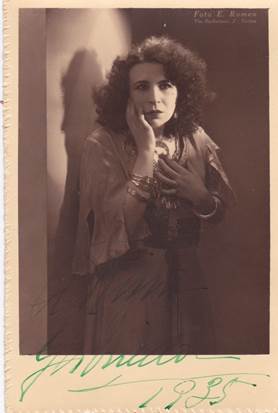
MEZZOSOPRANOS AND CONTRALTOS I HEARD
by Luciano Di CAVE from Rome
I have never heard , live that is , a voice I could describe as this is a contralto. There was one exception and I will talk later about it. I have heard many very good mezzos, but dark voices have always been rare and the great names I can cite are really few. Gabriella BESANZONI sang for the last time in Rome in 1938 (Carmen at Terme di Caracalla), but at that time I knew her name only through the scarce records listed in the HMV catalogue.

The first mezzo I met at Teatro Reale dell’Opera on April 21, 1940 was Gilda ALFANO in Trovatore with an excellent cast led by Maria Pedrini and Gino Bechi, the Manrico was Francesco Battaglia. Alfano was a good mezzo, her voice was not very dark but she sang well and was a good interpreter of Azucena. There are no records of her voice, perhaps some live fragment exists, but it is very difficult to find it.
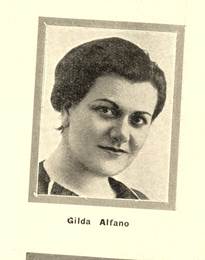
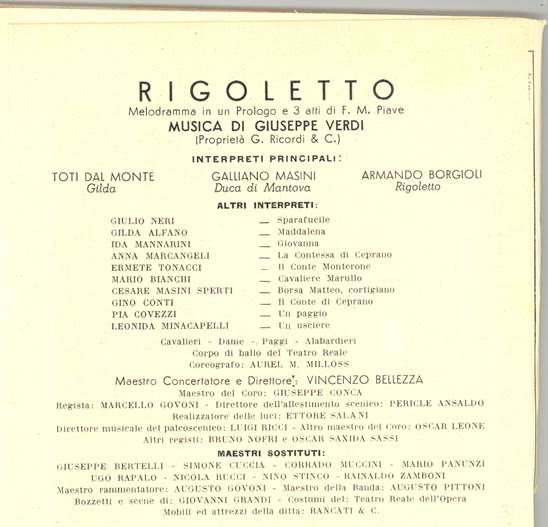 (programme Terme di Caracalla, 1938)
(programme Terme di Caracalla, 1938)
Another mezzo, who didn’t leave any record of her voice was Maria BENEDETTI a very imposing figure, tall and majestic. She was renowned for Amneris and Azucena, a role that she sang in 1937 with Giacomo Lauri Volpi. With the famous tenor she also sang in “Un Ballo in Maschera” in 1950 and this time I assisted to one of the performances. I was present to many of her Aidas and Trovatores and I can firmly say that she was very effective both in the voice, a solid voice of mezzo, and in the acting. It was a mere coincidence that Maria Benedetti came to my bookstore. She was looking for some books for a friend, I recognized her immediately, we began to speak and I complained the fact she had made no record. She regretted that and she confessed to have not profited by the occasion in a period when she was unable to leave Rome to go to Milan.
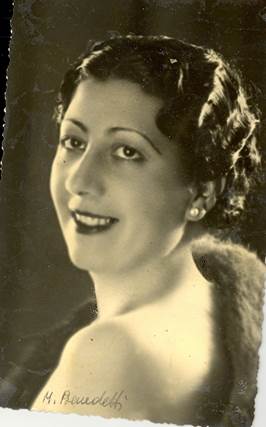
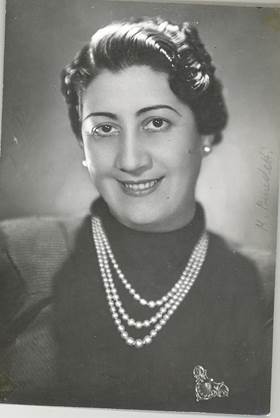
In 1945 I attended a performance of Falstaff, with Gino Bechi and Maria Caniglia. Quickly was a singer whose name was totally unknown to me: Matilde BLANCO SADUN (1). Later I was told she had a glorious career and had retired from the scene as she had lost her voice. But, miraculously in that period she could sing again (!) and I had the opportunity to hear, for the first time the true voice of a contralto. Her voice was really “black” and her low notes, very effective in the duet “Reverenza!”, were astonishing. Unluckily she did not appear again in the theatre and I think that this Falstaff meant her definitive retirement from the stage.
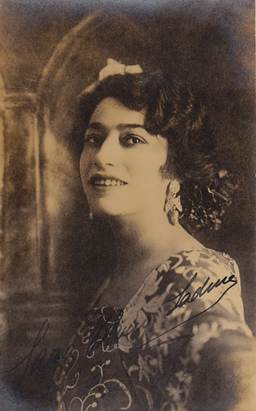
When I began to frequent lyric theatres, in the early forties the most famous names of mezzos were Ebe STIGNANI and Gianna PEDERZINI. To them, in the middle of the thirties another one was added: Cloe ELMO. This formidable trio made the history of opera, Stignani and Pederzini beginning their careers at the end of the twenties, Cloe Elmo a little later. Gianna Pederzini could not compete with the other two for the sheer beauty of voice, but she was
a very intelligent woman and her acting was really convincing. Her Carmen was, scenically, unexcelled and I remember her Rosina in “Barbiere di Siviglia” as the best I have ever heard sing by a mezzo. She was full of spirit and also her Isabella in l’Italiana in Algeri was remarkable. It’s a pity she avoided the last aria “Pensa alla patria”.
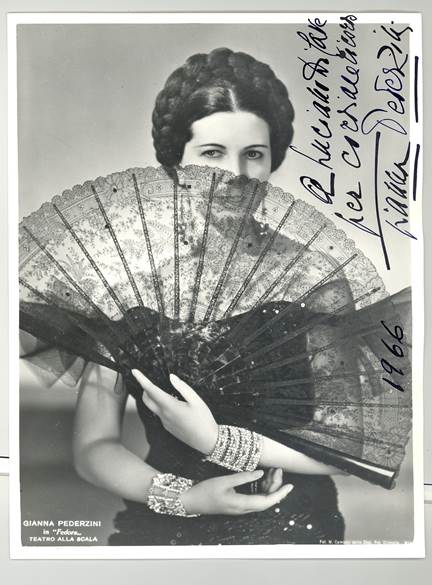
Talking about Pederzini it is not a secret to mention her love affair with Roberto Farinacci, one of the most famous hierarch (geràrca - leader) of the Mussolini entourage. In a recent interview to a Roman newspaper Giulietta Simionato said, with a bit of acrimony, that Pederzini and Elmo had a good career because of their political links. I have never known of political links concerning Elmo and, about Pederzini, she was already famous before meeting Farinacci and she never took undue advantage to abuse of her position. With the fall of Fascism, in 1943, she was compelled to flee from Italy to Argentina and her house was sacked. She came back after a short period of exile and she resumed gloriously her career …even if she had no more political links! I have known her, visiting her in her house twice and I must admit she was a charming woman, subtle and cultivated. Gianna Pederzini lived in Rome, in a flat near the Corso Trieste, then a high-class street. The flat was large, well-furnished, with a piano in the sitting room and some photos of composers and singers. A mutual friend introduced me to her and I went there for a second time because she had asked me to collect on an LP record some of her most uncommon recordings. I sent them to London and when the record was ready I brought it to her. (When she was in Argentina she recorded some songs for VICTOR. Among the others I remember “Torna a Surriento”). I also remember that Pederzini mentioned her performances with Rosa Raisa in Norma. She told me that Raisa’s voice was so powerful, that when she (Raisa) sang on the high notes, she (Pederzini) was compelled to move away from her. A great artist, she said of Raisa, a great voice.
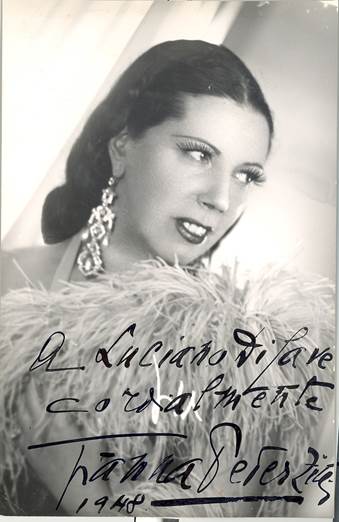
Elda Di Veroli, a well known soprano of the 20’s and 30’s told me of an episode which had as protagonists Elda herself and Gianna Pederzini. I regret to have forgotten the town where this event took place, but I think it was in Northern Italy, perhaps Brescia. The opera on stage was Mignon, an opera that was a war-horse for Pederzini, and Di Veroli was Philine. But there was another soprano who aimed at that role (I know her name, but I will
not reveal it). This soprano organized a conspiracy to destroy the successes of Di Veroli and when Elda began “Je suis Titania” a choir of screams and whistles broke out. The orchestra tried to continue, but every effort was useless. At that moment Pederzini appeared on the stage and her presence and her behaviour stopped the uproars. She embraced Di Veroli and addressed to the conductor to continue the performance. Di Veroli sang her aria and achieved a great success.
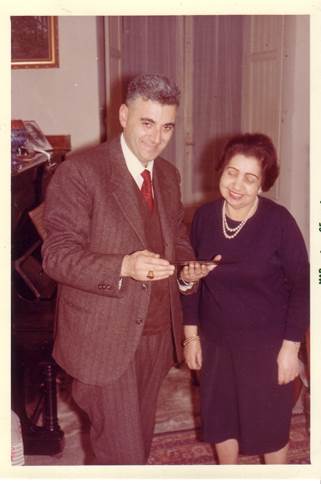
I have listened many times to Pederzini here in Rome, at the Teatro dell’Opera, the Teatro Adriano and the Teatro Quirino. She achieved many successes in Carmen, but I remember with emotion her Fedora and her Santuzza in Cavalleria. All dramatic parts, but she was also able to bring a touch of humour to the part of Rosina and Isabella.
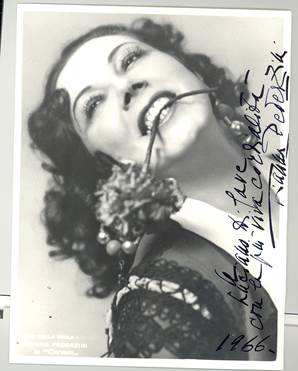
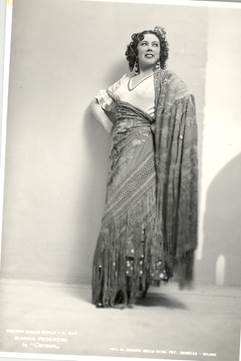
In 1945 I heard Eugenia ZARESKA in a performance of la Cenerentola, with Francesco Albanese. A good well-trained voiced, a beautiful woman, but rather cold.
A few years after the war, in 1946 and 1948, Giacomo Lauri Volpi sang for the Italian broadcasting Company, RAI two performances of “il Trovatore” . He was still in splendid voice and the selected casts were stellar: in 1946 Maria Pedrini, Cloe Elmo, Raffaele De Falchi, Luciano Neroni, conducted by Fernando Previtali. In 1948 Adriana Guerrini, Ebe Stignani, Raimondo Torres and Luciano Neroni, conducted by Tullio Serafin. The opera was broadcast, in Rome, in 1946 from the Teatro Quirino and in 1948 from the Teatro Valle. Luckily I could be present at both events and I can attest that the performances were superlative in both cases. I already knew the voices of Pedrini, Guerrini, Stignani, De Falchi and Neroni. Raimondo Torres, a Spanish baritone was a good surprise, but I knew Cloe Elmo only through her CETRA records, all excellent. In the flesh she raised my enthusiasm, it was very rare to listen to a voice so opulent, powerful and technically sure. I had another occasion to hear her some years later, in the same part of Azucena, this time at the Teatro dell’Opera with a young Mario Del Monaco, a wonderful Manrico. But the voice of Elmo was not the same that had galvanized me in 1946. Later I knew she was not in good health and her voice declined very speedily. It was a pity to lose such a beautiful voice who gave us splendid records: the duets with Gina Cigna are thrilling. There is also a document of her Azucena in the Trovatore broadcast from the San Carlo in Naples with Callas, Lauri Volpi and Silveri, but the voice had no more the splendid sound I had so admired in 1946. It is fair to remember that Arturo Toscanini chose Elmo as Quickly in his Falstaff at NBC, soon after Elmo sang this role everywhere, from the Metropolitan to La Scala, always with great success.
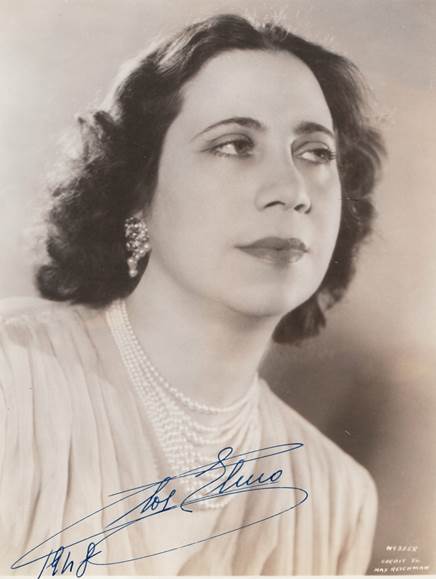
And now we have arrived to Ebe STIGNANI, the Azucena of Lauri Volpi in 1948. She was in splendid voice, she had begun to sing at the end of the ‘20s but years had passed giving to her voice a glamour and a security I have rarely found in singers. She didn’t have the glamorous appearance of Pederzini, she was not a great actress, but, ah! , when she opened her mouth you were completely enchanted by this voice. A powerful voice resounding in the theatre with solid low and medium registers and with an amazing ease on the high notes. She could arrive to the high C without difficulty. I have heard her in Norma (with Caniglia and Gigli and with Callas) and I must confess that my attention was completely attracted by her voice only. Not even Gigli, whom I adored, won my interest. Trovatore with Lauri Volpi was another milestone in my operatic experience, the only regret is that RAI didn’t record any of these two splendid performances. Lauri Volpi was called by RAI in 1951 to record il Trovatore, but, though still valid, his voice had lost part of its splendour. Stignani was never called to record Azucena, but a tape has survived from La Scala, with Callas and Penno.
In 1954 I listened to Stignani for the last time, in la Favorita, at the Teatro dell’opera with a good Gianni Poggi, an underrated tenor, and she was still in good voice. We have many recordings of Norma with Callas, but, even in the first, recorded for Columbia, the opulence of her voice had gone. The “Adalgisa” she had recorded for CETRA, with Cigna, in the ‘30s
is splendid though.
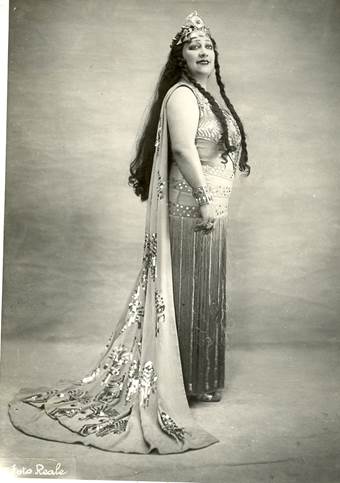
I heard Stignani in Don Carlos at the Teatro dell’Opera more than once and her performance reached the top at the aria “O don fatale”. This aria had already been recorded by CETRA in the late ‘30s and it is one of my favourite records, moreover there is the complete opera realized by CETRA in 1951 for the Verdian year. And this performance, to which I have attended in the RAI auditorium, deserves to be mentioned. The cast was stellar, with Caniglia, Stignani, Picchi, Silveri, Rossi Lemeni. The audience followed the performance with the greatest attention. In RAI, during the broadcast, the audience must be silent, it is severely forbidden to clap at the end of an aria. The audience can only clap at the end of the acts. On that night this rule was broken: when Stignani started to sing O don fatale everyone realized that something unusual was happening. Her voice seemed a miracle, so fluent, so easy and so powerful. I have already said that acting was not a virtue of Stignani, but she could communicate all the emotions through the splendour of her voice. So, that night, we heard a voice, splendid in every note, that could express all the desperation of Eboli. At the end of the aria, the entire audience jumped to their feet, mad with enthusiasm. Really an experience to remember.
But… there is a but. If you listen to the recording of Don Carlo you will find no trace of applause or signs of enthusiasm. The performance of O don fatale is very good, but the atmosphere created by the singer is totally absent. In fact the artistic (!) directors of Cetra had the “brilliant” idea to cut off the live performance that had had so great a success and substituted it with a new recording released in the studios!
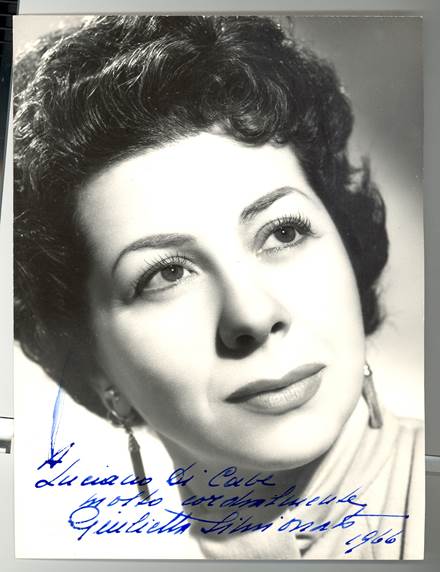
I heard Giulietta SIMIONATO in “le Nozze di Figaro” (Cherubino) and in il Barbiere di Siviglia.
She was a perfect Cherubino and a charming Rosina, but I don’t think she was a Rossinian singer. Her voice, well-trained and of good quality, was more suited to operas as La Favorita, La Forza del destino or Cavalleria Rusticana.
I heard Elena NICOLAI in Orfeo e Euridice and Don Carlo. A good mezzo, with a voice which could manage the difficulties of Eboli, but nothing more. Fiorenza COSSOTTO, heard in Norma and Don Carlo, called my attention. A beautiful voice, solid and with a good vocal technique, she sang every score with ease and security. Azucena in Trovatore was, with Eboli, one of her favourite roles.
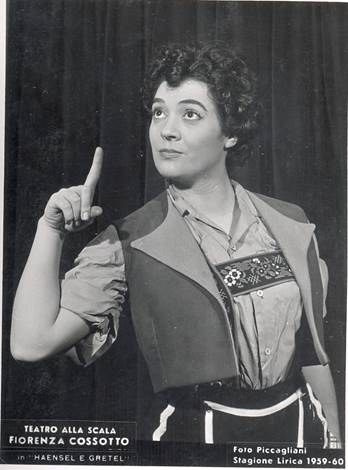
At the end of the ‘40s Italian Columbia issued a record sung by a mezzo who was totally unknown to me. Her name was Jennie TOUREL and the aria was the “Rondò finale” from la Cenerentola by Rossini. I bought the record more for the aria (it was the first Italian recording after Supervia’s) but I was struck by the artistry and the grace of this singer. Some months later Jennie Tourel sang in Rome, for a concert at the Teatro Eliseo. I went to listen to her and I was delighted by the charm and the art of this enchanting singer. The arias from “La Perichole” by Offenbach were exceptional and so were all the arias and Lieder she sang. Useless to say I tried to buy all the records I could find in Italy.
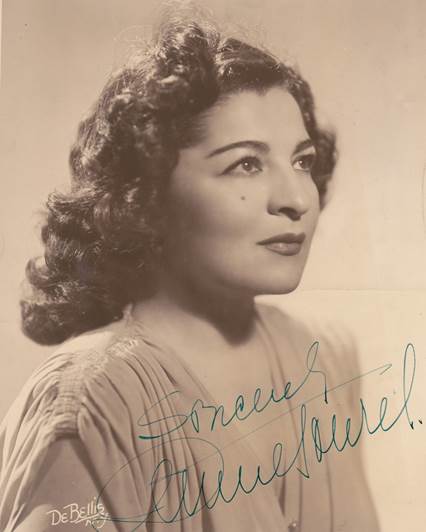 <
<
I know Pia TASSINARI as “mezzo” only by her recordings, for many years she had been an excellent soprano which I have admired in Manon and Tosca.
I would like to add some lines to the name of Fedora Barbieri. She has sung many, many times at Teatro dell’Opera in Rome, I have listened to her once only. It may appear strange but there are many cases in which I wasn’t able to listen to famous singers. This fact has no influence on the great admiration I have for this singer. I have listened to her through radio and records. I like very much her duets from Trovatore with Jussi Bjørling. Some years ago she took part in a broadcast in Rai and she was so nice and full of humour that I hoped she could be called again. But, alas, she died a few months after. In the first part of her career she was shining as Amneris, Azucena, Leonora in Favorita, Eboli in Don Carlos. In the second part of her career her voice began to show some faults and she retired to easier roles, (vocally speaking). She was able to give us a splendid Quickly in Falstaff and, at the very end of her career she sang as Lola in Cavalleria Rusticana and later as mamma Lucia, Berta in Il Barbiere di Siviglia, Madelon in Andrea Chenier. As for all the great singers her career lasted more than thirty years.
I have limited my remembrances to the ‘40s and the beginning of ‘50s and I have not quoted some singers I could not hear in flesh. Going on to the ‘60s and ‘70s we find many glorious mezzos and a great voice, a wonderful mezzo (almost a contralto), Marylin Horne, but an entire book would be necessary to list all of them. Teresa Berganza was a delicious Rosina, but I listened to her in the ‘60s. I had the pleasure to take part in a radio broadcast with her and Sesto Bruscantini. A delightful woman, simple and modest. At that time she was seriously studying the role of Carmen. We know that her Carmen was excellent.
I can be satisfied of the singers I have heard in the ‘40s and ‘50s, and the name of Ebe Stignani is there, a voice that shines like a star in the lyric firmament. If you want to have an idea of the wonderful voice of Cloe Elmo buy the records she realized till 1949-50. And only the CETRA records (and a few sides she sang for La Voce del Padrone, including a duet with Gigli) can do justice to this great singer. Also Pederzini made a good number of records, but she was a singing actress and to have a complete idea of her value it was necessary to see her on the stage. She sang till the late fifties and, though her voice was gone, she succeeded to emerge in operas such “Les dialogues des Carmelites, la Medium and the Queen of Spades”.
(1) Matilde Blancun was a Spanish contralto. She probably got the name Sadun through marriage.